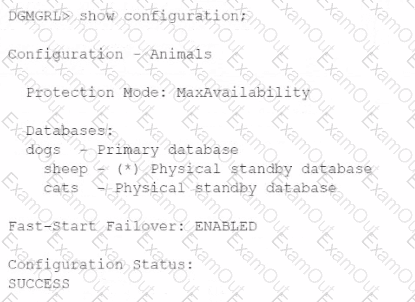Examine the Data Guard configuration: DGMGRL> show configuration;
Configuration - Animals
Protection Mode: MaxPerformance
Databases:
dogs- Primary database
sheep - Physical standby database
cats- Snapshot standby database
Fast-Start Failover: DISABLED
Configuration Status: SUCCESS
You receive an error while attempting to raise the protection mode to Maximum Protection:
DGMGRL> edit configuration set protection mode as maxprotection;
Error: ORA-16627: operation disallowed since no standby databases would remain to support protection
mode
Failed.
What can you conclude based on this error?
You must propose an Oracle Data Guard configuration for a database supporting an OLTP workload that meets these permanent requirements:
Data loss is not permitted.
Read-only applications should not connect to the primary database instance.
Additionally, there are these requirements, only one of which is ever done at any one time:
It should be possible to apply and test designated patches with a minimum amount of downtime.
Upgrading to a new database release should be performed with the least possible amount of downtime.
New application software releases should be tested against an exact up-to-date replica of the production database.
You propose a primary database with one physical standby database configured in Maximum Protection mode.
Which requirements do you meet?
Examine the procedure that you plan to execute on your logical standby:
SQL> EXECUTE DBMS_LOGSTDBY.SKIP(stmt => 'DML', schema_name => 'HR', object_name => 'EMPLOYEE');
What is a prerequisite for execution of this procedure?
Which two are true concerning the configuring of Flashback database in a Data Guard environment?
Examine the Data Guard configuration:

What happens if you issue "switchover to sheep;" at the DGMGRL prompt?
Which three are true concerning database states after a successful switchover?
A customer asks you to propose the most appropriate solution for this set of requirements:
We need a disaster recovery solution that enables us to fail over from our production database with zero data loss.
We want to generate reports from the proposed standby database at the same time that it is used for data protection.
Developers may need to test occasionally on a copy of the live database
Which TWO solutions would you recommend?
Which three are prerequisites for using Data Guard Broker?
Which three statements are true about snapshot standby databases?
Which THREE are always benefits of using a logical standby database?

